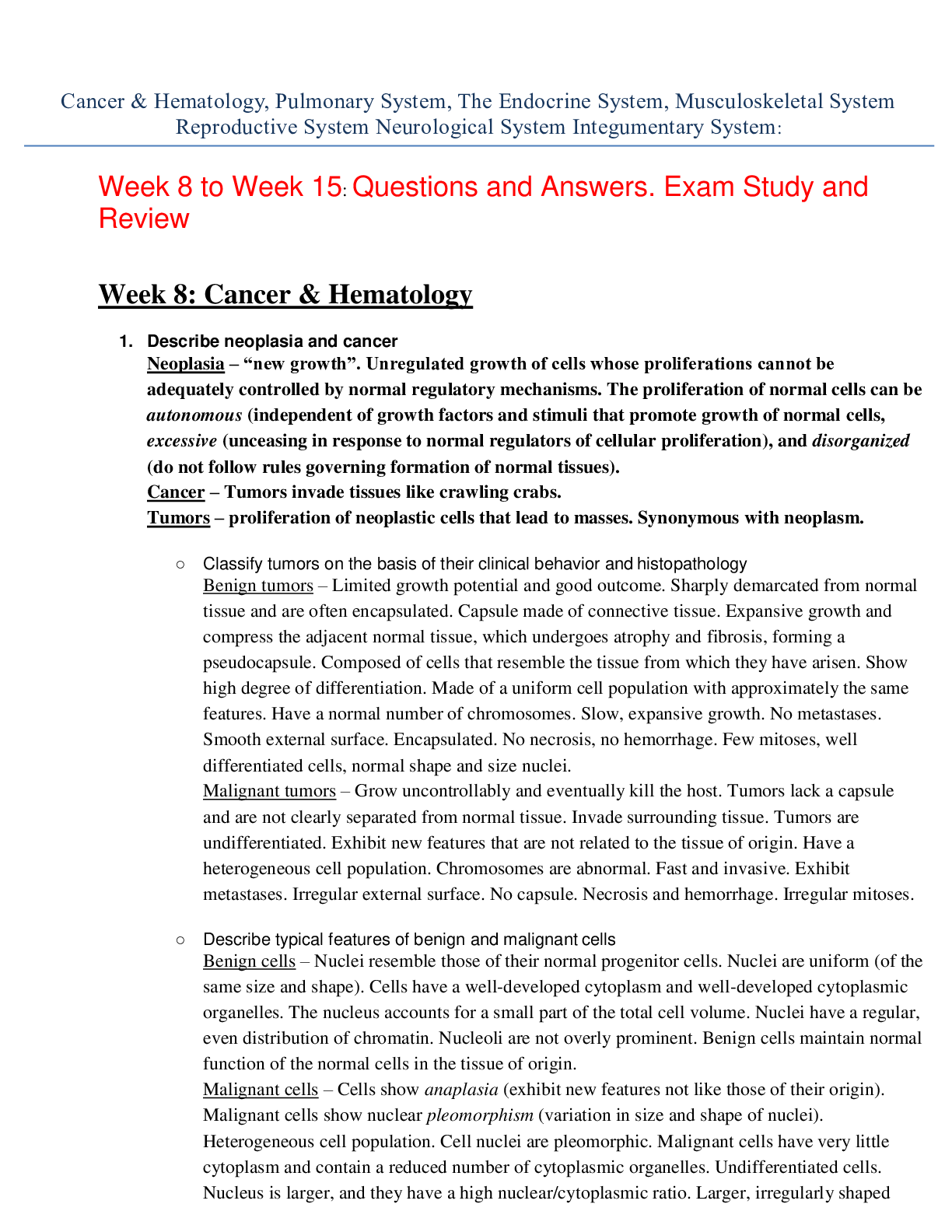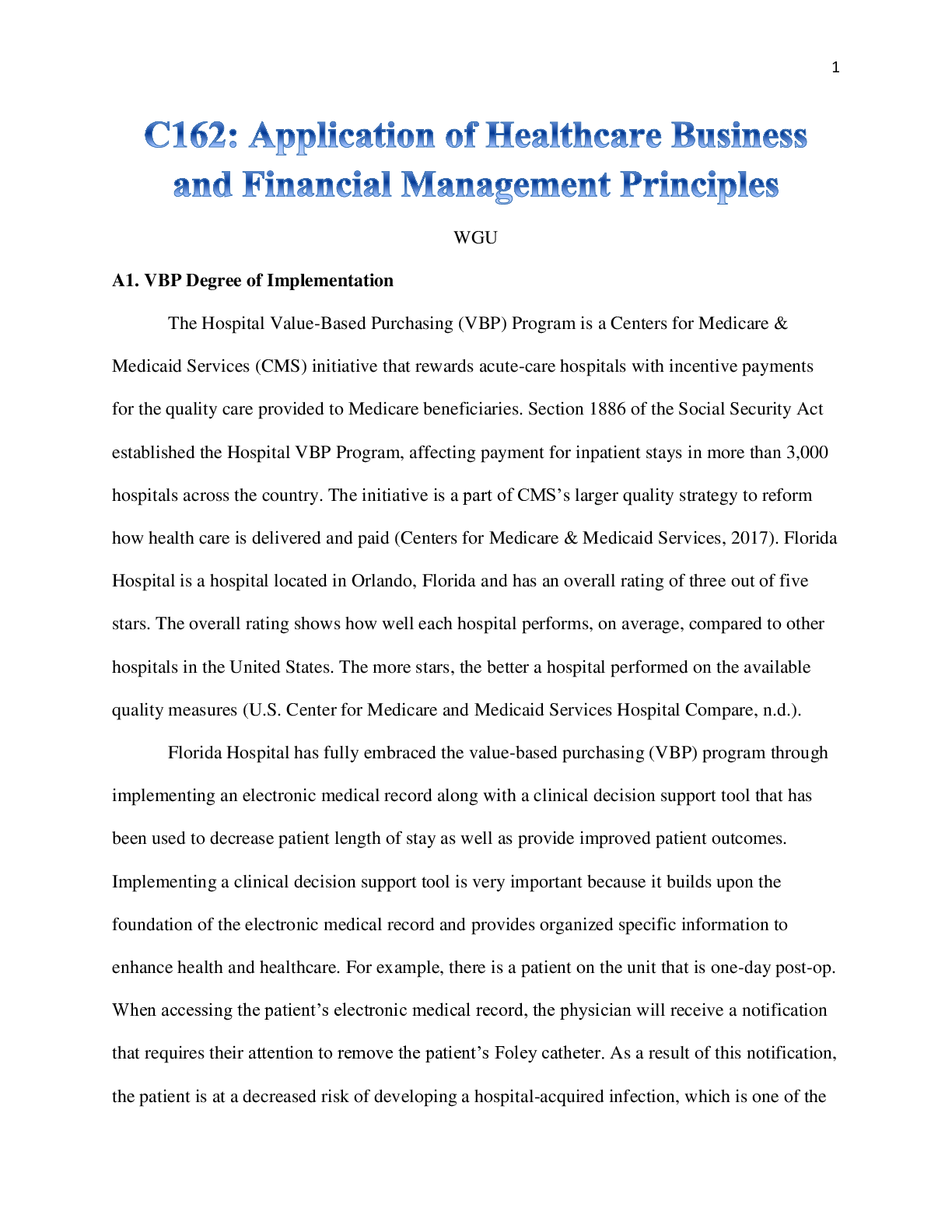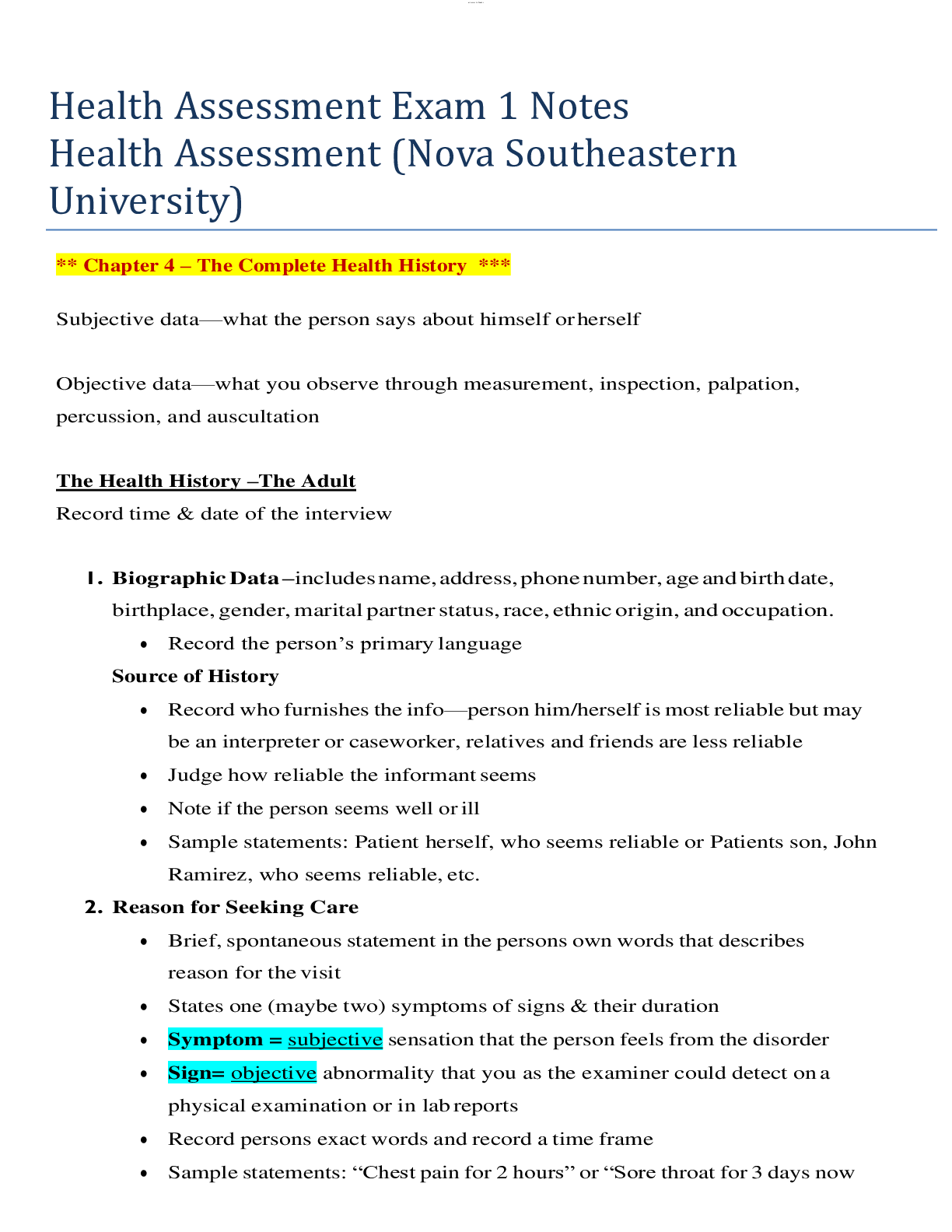Pathophysiology > Class Notes > Cancer & Hematology, Pulmonary System, The Endocrine System, Musculoskeletal System Reproductive Sys (All)
Cancer & Hematology, Pulmonary System, The Endocrine System, Musculoskeletal System Reproductive SystemNeurological SystemIntegumentary System: ::: Questions and Answers. Exam Study and Review
Document Content and Description Below
Describe neoplasia and cancer Classify tumors on the basis of their clinical behavior and histopathology Benign tumors Malignant tumors Describe typical features of benign and malignant cells ... Benign cells Malignant cells Describe the epidemiology of cancer: global impact, environmental factors, age, acquired predisposing conditions and genetic predisposing dentify common childhood cancers Wilm’s tumor-renal malignant tumor in infancy and childhood. Neuroblastoma, Wilms tumors, retinoblastoma, acute leukemias, and rhabdomyosarcomas. dentify common childhood cancers Wilm’s tumor-renal malignant tumor in infancy and childhood. Neuroblastoma, Wilms tumors, retinoblastoma, acute leukemias, and rhabdomyosarcomas. Describe the avenues for metastatic spread 1.Through the lymphatics. 2.Via blood (hematogenous spread), and 3.by seeding surfaces of body cavities Describe angiogenesis Angiogenesis is the formation of new blood vessels Describe the evidence for viral carcinogenesis with ○ Human papillomavirus Describe oncogenes and tumor suppressor genes and explain their clinical significance ○ Oncogenes Describe the morphology of peripheral blood ○ Formed Elements of the blood Describe anemia and list the major forms Thalassemia: genetic defect in the synthesis of HbA that reduces the rate of globin chain synthesi Hemolytic anemia Hereditary Spherocytosis: genetic defects that involve structural proteins that form RBC cytoskeleton Compare polycythemia vera with secondary polycythemia Polycythemia or erythrocytosis: dx char. by inc. # of RBC in circ. → 2 forms primary (or polycemhemia vera) or secondary Describe leukemia, lymphoma and multiple myeloma ○ Explain common pathologic findings in leukemia and lymphoma and relate them to clinical syndromes Acute Lymphoblastic Leukemia (ALL) Acute Myelogenous Leukemia (AML) Chronic Myelogenous Leukemia (CML): Chronic Myelogenous Leukemia (CML) Chronic Lymphocytic Leukemia (CLL) Chronic Lymphocytic Leukemia (CLL): ompare and contrast Hodgkin’s lymphoma with non-Hodgkin’s lymphoma (NHL): NHL includes follicular lymphoma, diffuse large B-cell lymphomas (DLBL), and Burkitt’s lymphoma. Clinical features of NHL include lymph node enlargement, systemic symptoms such as fatigue, fever, weight loss, sweating, & extranodal tumor spread. Explain congenital bleeding disorders and their pathogenesis Thrombocytopenia: Decreased production or increased destruction, Explain the Coagulation Cascade (Robbins and Cotran, pages 118-120) ● Clotting cascade is the third step in normal hemostasis (1.vasoconstriction, 2. Activation and primary platelet plug (within seconds) ● During tissue injury, circulating platelets come into contact wBlood Coagulation Most common hereditary disorder of hemostasis – von Willebrand disease ● Most common hereditary disorder of coagulation – hemophilias ● Major causes of acquired coagulation disorders: ○ Vit K deficiency ○ Liver disease ○ DIC ○ Factor VIII, IX (hemophilias), Factor V (Leiden) autoantibodies usually circulating anticoagulants Describe the normal respiratory system and its main functions Respiratory: Main function Larynx: Ventilation, alveolar-capillary membrane and the diffusion of oxygen and carbon dioxide, oxyhemoglobin association and de association, transport of carbon dioxide from cells Respiration occurs at the alveolar/capillary membrane Identify the normal values for arterial and venous gasses and their significance Arterial blood gases ar Describe pulmonary congenital diseases Congenital Diseases ● Rare ● Pulmonary hypoplasia: defective development of both lungs, resulting in decreased weight, volume, and acini for body weight and gestational age Pulmonary sequestration: Describe the pathogenesis of pneumonia and compare bacterial and viral pneumonia ○ Can be caused by bacteria- most common, viral, or fungi, protozoa, or parasites which are the least common The pathology of Pneumonia is Alveol ar pneumonia or interstitial pneumonia. Alveolar Pneumonia: usually caused by bacteriaBronchopneumo nia- Hypostatic Pneumonia Interstitial Pneumonia Explain Community-acquired vs. Health Care Associated vs Hospital Acquired (Robbins and Cotran, page Morphology and Pathology ● URIs are marked by mucosal hyperemia and swelling, lymphomonocytic and plasmacytic infiltration of the submucosa, and overproduction of mucus secretions Clinical Course ● The clinical course of viral infections is extremely varied. Many cases masquerade as chest colds ● Cough may be absent Describe common causes of pneumonia in children ■ Staphylococcus aureus is an important cause o Describe the pathogenesis of typical lesions of pulmonary tuberculosis TB is a chronic bacterial infectious disease caused by M. tuberculosis Typical complications resulting from dissemination of TB include: ■ Miliary TB: resemble millet seeds- small granulomas. Describe chronic bronchitis and typical lesions and complications of the disease ■ Defined clinically as excessive production of tracheobronchial mucus causing cough and expectoration for at least 3 months during 2 consecutive years. Discuss COPD, emphysema, its pathologic changes and clinical symptoms ■ Defined as a disease state characterized by airflow limitations Describe the pathophysiologic manifestations of as Explain sarcoidosis and chronic immune mediated disease s Diagnosis: Biopsy of lymph nodes, bronchi, liver, skin, or enlarged salivary glands. Granulomas are composed of epithelioid macrophages and giant cells surrounded, at the periphery by a narrow rim of lymphocytes Define pneumoconiosis - Lung diseases caused by inhalation of mineral dusts, fumes, various organic/inorganic particulate matter - Most are classified as occupational; Describe the pathogenesis of acute respiratory distress syndrome (ARDS) ● Acute lung injury (ALI)=Characterized by abrupt onset Discuss the pathogenesis and differential diagnosis of pleural effusions ○ Pleural effusion is excess fluid in the pleural space. This fluid can be either transudative (non-inflammatory) Describe obstructive sleep apnea apnea means absence of spontaneous breathing. Occasional apneas occur during normal sleep, but in persons with sleep apnea Obstructive sleep apnea most commonly occurs i Describe the typical location, gross appearance and histologic findings associated with various forms of lung cancer ● Lung cancers may arise from several cell types, including (1) Squamous cell carcinoma (30%)- metaplastic squamous epithelium (2) Adenocarcinoma (40% Discuss the pathogenesis, etiology and symptoms of epiglottis and laryngitis, tracheobronchitis and bronchopneumonia Epiglottitis: caused by Haemophilius infulenzae Laryngitis · Laryngitis may occur as the sole Tracheobronchitis/Bronchitis: occurs when the windpipe or bronchi becomes inflamed Bronchopneumonia: also known as lobular pneumonia Describe the normal anatomy and function of the pituitary, thyroid, parathyroid glands and adrenals ○ Pituitary - located intracranially in the sella turcicia, consists of anterior Thyroid - endocrine gland located in the neck Parathyroid - located in the neck, behind the thyroid Adrenal Gland: paired organ located in retroperitoneal space of the abdominal cavity and attached the the upper pole of each kidney Explain the pathogenesis of pituitary hormonal hypofunction and hyperfunction and syndromes that might develop under these conditions Hyperfunction: Tumors or hyperplasia. May be due to pituitary adenomas Hypofunction: Due to incomplete development, atrophy or destruction of secretory cells. Rare, but may happen at any age. May involve all pituitary Symptoms of anterior pituitary hypofunction: ● Dwarfism in children due to growth hormone deficiency Diabetes insipidus: Marked by a lack of ADH secondary to destructive le cromegaly- caused by somatotropic adenomas. Enlargement of acral parts of the extremities ex: hands, toes, fingers, tongue, jaws, nose Explain the pathology of thyroid diseases Define Graves’ disease and explain its pathogenesis and main symptoms Graves disease is an autoimmune disorder resulting from breakdown of self tolerance to one or more thyroid components Describe causes of hypothyroidism and symptoms of the condition ■ Causes: functional failure of the thyroid gland and inability to meet body’s demands, Describe thyroid nodules and neoplasms Nodular Goiter Discuss four thyroid tumors and their main function Papillary- 80% of all malignant thyroid tumors Discuss causes of hyperparathyroidism and explain the pathologic findings in the disease ○ Primary hyperparathyroidism ■ Caused by parathyroid hyperplasia OR neoplasia (adenoma) Describe diseases of the adrenal cortex and the adrenal medulla ○ Explain Addison’s disease and the symptoms of the disease Explain Addison’s disease and the symptoms of the disease Explain Cushing’s syndrome = hypercortisolism Endogenous Cushing's syndrome and Cushing's disease are rare Hyperaldosteronism typically caused by an adenoma of the zona glomerulosa presents Describe the symptoms of pheochromocytoma and neuroblastoma Neuroblastomas Describe the normal anatomy and physiology of the musculoskeletal system Describe the cells of the bone: -osteocyte:mature bone cells; bones are composed of these cells, help control calcium and phosphate levels in the microenvironment Describe the anatomy of joints: Describe developmental and genetic disorders Achondroplasia: Osteogenesis imperfecta: - bone defect caused by mutations of gene for collagen Describe infectious diseases ○ Osteomyelitis ○ Bacterial infection of the bones, usually Describe metabolic disorders ○ Osteoporosis ● Multifactorial disease characterized by Pathogenesis: Primary Osteoporosis Etiology unknown, but certain factors are Causes of Secondary Osteoporosis ● Hormonal disturbances: excess cortisol; Explain traumatic injuries (fracture, dislocations simple- single frac line Describe bone tumor Benign tumors 1. Osteoma (bone cells) 2. Chondroma (cartilage cells) 3. Fibroma (fibroblasts from nonossifying fibroma) 4. Giant cell tumor (benign in most cases but may recur) Rheumatoid Arthritis Chronic systemic disease of unknown etiology Characterized by: 1. Chronic, symmetric inflammation of joints (primarily synovial) Significant, but not diagnostic, laboratory findings indicative of immune disorder 3. Variable extraarticular findings Describe fibromyalgia: Explain rhabdomyolysis Describe the pathogenesis of muscle diseases Describe the development of the reproductive systems. I am not quite sure what they want here because R&C Identify female internal and external genitalia Describe the menstrual cycle.Describe the menstrual cycle. ○ Generally considered a 28 day cycle ○ The hypothalamus secretes GnRH -> Describe spermatogenesis and male sex hormones. (I also couldn’t find any info in the books on this so I came up with this. Please feel free to change anything) Identify male internal and external genitalia Describe the progressive and cyclical hormonal changes associated with female breast tissue development.○ Estrogens initiate growth of the breasts and of the milk-producing apparatus. ○ They are also responsible for the characteristic growth and external appearance of the mature female breast. ■ However, they do not complete the job of converting the breasts into milk-producing organs. List the test used to evaluate reproductive health and function. Blood tests of FSH/LH/Estradiol- It is a blood test drawn on day 2, 3, or 4 of the cycle is a reflection of the female partner’s ovarian reserve of how well to expect the ovaries respond to stimulation. This is done because women may have normal cycles, but not be able to become pregnant for years. Pap smears test for cervical cancer and HPV infections. Infectious screenings of STDs can adversely affect the outcome of treatment or pregnancy. Pre-Pregnancy Screen- blood type and Rh Factor, Rubella titer, CBC- Rubella can cause serious birth defects if pregnant; anemia and other blood disorders are identified with CBC. Prolactin, TSH- Subtle abnormalities that can effect pregnancy. Prolactin stimulates milk production during breast-feeding. TSH with thyroid. US to assess muscles of uterus and assess ovaries. Pelvic Ultrasound- picture of the ovaries and structures of the lower belly- pelvis. 8. Identify normal changes in the reproductive systems that occur with advancing age; describe peri-menopause. ○ Peri-menopause is often used interchangeable with premenopause. Premenopause is when there are no symptoms of going through perimenopause or menopause. Start to experience symptoms of menopause- changes in the period cycle, hot flashes, sleep disturbances, or mood swings. Perimenopause occurs well before officially hitting menopause. 8-10 years approximately before menopause. Occurs during the 30s-40s. It is marked by a drop-in estrogen. ○ Symptoms of perimenopause may include: irregular periods, periods that are heavier/lighter than normal, worse PMS before periods, breast tenderness, weight gain, hair changes, increased heartbeat, headaches, loss of sex drive, concentration difficulties, forgetfulness, muscle aches,UTIs, fertility issues, hot flashes, night sweat, depression, anxiety/irritability, mood swings, insomnia, fatigue, dry skin, vaginal dryness, frequent urination. ○ Can also have increased cholesterol levels. Distinguish between delayed and precocious puberty. Precocious puberty in males: premature activation of Leydig cells ypes of menstrual disorders There are many types of menstrual disorders, including: ● Abnormal uterine bleeding- Excessive or prolonged menstrual bleeding Describe pelvic inflammatory disease Describe vaginitis, cervicitis, vulvitis, and bartholinitis. Vaginitis -Vaginitis i . Characterize the benign growth and proliferative conditions of the female reproductive tract. Benign growths: 1. Leiomyom Characterize malignant tumors of the female reproductive tract Characterize malignant tumors of the female reproductive tract 14. Discuss common disorders of the male reproductive tract. 15. Describe sexual dysfunction in males Describe breast disorders. ○ Breast CA is the most common cancer in women (1/9 women will develop breast CA) 7. Discuss current status of sexually transmitted infections. (Does this mean the epidemiological status?) 18. Characterize the bacterial STDs. Gonorrhea Identify systemic sexually transmitted infections Identify the anatomy and the structural and functional subdivisions of the nervous system. ● Identify the main regions of the brain and characterize their associated structures and functions. Describe the structure and function of the spinal cord ■ She used this picture in lecture and I found it very helpful Discuss the autonomic NS and the general functions and identify the neurotransmitter secreted by pre and postganglionic fibers in the ANS Identify changes in the CNS that occur with aging Describe Nervous System pathology Describe the pathogenesis of cerebral edema. ■ Brain parenchymal edema (aka cerebral edema) is the fluid leakage from blood vessels or injury cells of the CNS Describe the pathogenesis of cerebral edema. ■ Brain parenchymal edema (aka cerebral edema) is the fluid leakage from blood vessels or injury cells of the CNS Discuss the pathogenesis and manifestations of spinal cord injuries. ● Hyperextension injury: forehead causes hyperextension and rupture of the anterior spinal ligaments with compression of the posterior side of the spinal cord. Describe degenerative disk disease, low back pain, and herniated intervertebral disks. Describe the pathology of Parkinson’s and Huntington’s disease and correlate the pathologic findings with the clinical symptoms Characterize brain tumors in children and adults and describe their pathologic and clinical features Gliomas- tumors arising from glial cells, they are all malignant. Glioblastoma is the most common CNS tumor. Tumors of neural cell precursors and undifferentiated cells- Describe the pathogenesis of addiction: Addiction is a chronic disease, best treated Describe the normal skin and its functions xplain pathology of the skin ● Discuss the short-term and long-term effects of ultraviolet light on the skin Distinguish among the various disorders of pigmentation and melanocytes Describe acute inflammatory dermatoses and chronic inflammatory dermatoses Describe acne vulgaris and explain the pathogenesis Describe various causes of eczema ● Exogenous Eczema: Differentiate between atopic and diaper dermatitis in infants and children. [Show More]
Last updated: 3 years ago
Preview 1 out of 69 pages

Buy this document to get the full access instantly
Instant Download Access after purchase
Buy NowInstant download
We Accept:

Reviews( 0 )
$5.00
Can't find what you want? Try our AI powered Search
Document information
Connected school, study & course
About the document
Uploaded On
Mar 22, 2020
Number of pages
69
Written in
All
Additional information
This document has been written for:
Uploaded
Mar 22, 2020
Downloads
0
Views
176


























